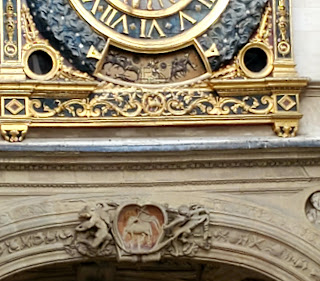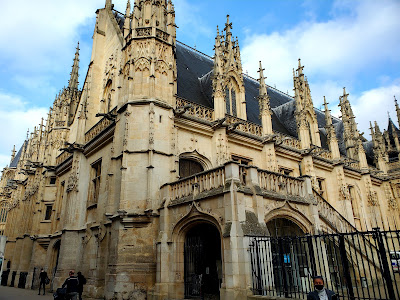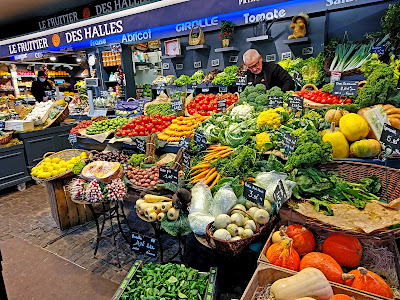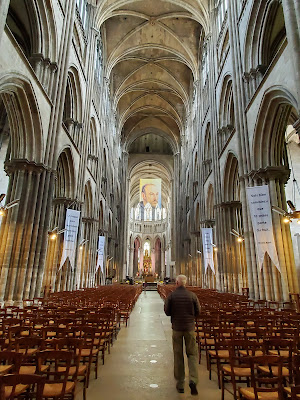
Founded by the Romans 2,000 years ago, Rouen was made the capital of Normandy by the Viking leader, Rollo, in the 10th century. Rollo was baptized into the Christian faith with the name of Robert and began a lineage that extended from William the Conqueror to Queen Elizabeth II.
Rouen's historic wealth was built on its wool and on trade. It was once the last bridge across the river before the Atlantic. In April, 1944, the Allies weakened the control of Normandy prior to D-Day and destroyed 50 percent of Rouen, mostly the industrial suburbs.
Most of the historic Old Town survived and that is what we set out to explore.
We leave the ship and head over to the Rue du Gros Horloge, the main pedestrian street through the Old Town.
We walk under the Great Clock, circa 1528, which decorates the former City Hall.
The silver orb above the clock makes one revolution in 29 days, following the cycle of the moon.The town medallion sculpted into the stone below the clock features a sacrificial lamb, which has both a religious meaning and commercial significance since wool was the source of Rouen's wealth.
The Palace of Justice is a huge, impressive building dating from 1550. Rouen is the capital of Normandy and was, at one time, an independent country from France.
This was the Jewish quarter until the early 14th century when the Jews were expelled from France, their homes destroyed, and the city took their land, on which this parliament building was built.
The modern Joan of Arc Church is a tribute to the teenager who rallied French soldiers to drive out English invaders. The cross in front of the church marks the spot where Rouen publicly punished and executed people and where Joan of Arc was burned alive in 1431 after being falsely accused of heresy. She was eventually canonized as a saint in the Church.
Statue of Joan of ArcThe inside of the church is very modern with beautiful stained-glass windows which were removed from the church of Saint-Vincent in 1939 and hidden during WWII . Wise decision as that church was destroyed.
The look is very Scandinavian; a reminder of Normandy's Nordic roots. The wood ceiling resembles a ship's hull.
Outside the church in the Place du Vieux Marche, (Old Market Square) is the oldest restaurant in France, Restaurant La Couronne. It was here, in 1948, that American chef Julia Child ate her first French meal. That meal changed her life and she ultimately became the famous chef and author.
The covered market place
The chocolate shops sell chocolate-covered almond tears of Joan of Arc
Up next was the Notre-Dame Cathedral, constructed between the 12th and 14th centuries. It was devastated during WWII and has been undergoing constant rebuilding.
Inside the church looking down the Gothic nave.
Chapel dedicated to Joan of Arc
At the centerpiece is a statue of Joan of Arc being burned.There are several medieval stone statues lining the hall. Centuries ago they were outside in niches high above the street.
Another look at the outside and you can see where the statues had been in the now empty niches.There are several stone tombs, This one is for Rollo, the first duke of Normandy who died about 932 . Rollo was chief of the first group of Vikings who settled here.
And in the next tomb is King Richard the Lionheart.
Beautiful stained-glass window from the 13th century. This window tells the legend of Saint Julian.
Looking at the ceiling we can see a lighter-colored patch. In 1999 a fierce winter storm caused a spire to crash through the roof.
The outside spire is 500 feet high, the tallest in France.
The rose window from outside. It dates from around 1300. During WWII the glass was taken out.
Over the door of the north transept is the carving depicting the Last Judgment.
We continued down the street filled with half-timbered houses. The limestone from the cliffs of the Seine River was of poor quality, but oak was plentiful. So, the houses were built half-timbered.
During the great plagues of the Middle Ages, as many as 2/3 of the people of Rouen died. This half-timbered courtyard was a mass grave. It was hard to deal with so many corpses so they were piled into a mass grave, drenched in lime
We headed over to Rouen's Museum of Fine Arts as we thought there was a Monet painting of the cathedral on display.
We looked everywhere, tried to follow the museum map, and even tried to question the museum aides, who pointed us to an area that was closed to the public due to renovation.So, no such luck to see one of Monet's paintings. He painted 30 different studies of the frilly Gothic facade at various times of the day, to show different impressions as the light changed. Wish we could have seen at least one of them.
We headed back to the ship and on the bridge over the Seine River, next to where our ship is docked, is this statue. It is a statue of the Vikings departing to conquer this land.
Having watched the Vikings series from the History Channel, we could envision the ships finding the mouth of the Seine River and heading upstream to Paris.
That evening we were entertained on the ship with a little of the cancan dancing.
In the morning we sail to our last port, Honfleur. It is from here that we will go to the D-Day Beaches.
To continue reading, scroll down and click "Newer Post".









































No comments:
Post a Comment